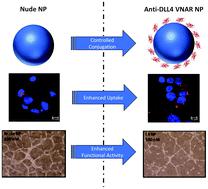Our official English website, www.x-mol.net, welcomes your
feedback! (Note: you will need to create a separate account there.)
Anti-DLL4 VNAR targeted nanoparticles for targeting of both tumour and tumour associated vasculature.
Nanoscale ( IF 5.8 ) Pub Date : 2020-06-29 , DOI: 10.1039/d0nr02962a Adam Leach 1 , Peter Smyth , Laura Ferguson , John Steven , Michelle K Greene , Cristina M Branco , Aidan P McCann , Andrew Porter , Caroline J Barelle , Christopher J Scott
Nanoscale ( IF 5.8 ) Pub Date : 2020-06-29 , DOI: 10.1039/d0nr02962a Adam Leach 1 , Peter Smyth , Laura Ferguson , John Steven , Michelle K Greene , Cristina M Branco , Aidan P McCann , Andrew Porter , Caroline J Barelle , Christopher J Scott
Affiliation

|
Whilst there is an extensive body of preclinical nanomedicine research, translation to clinical settings has been slow. Here we present a novel approach to the targeted nanoparticle (NP) concept: utilizing both a novel targeting ligand, VNAR (Variable New Antigen Receptor), a shark-derived single chain binding domain, and an under-investigated target in delta-like ligand 4 (DLL4). We describe the development of an anti-DLL4 VNAR and the site-specific conjugation of this to poly(lactic-co-glycolic) acid PEGylated NPs using surface maleimide functional groups. These nanoconjugates were shown to specifically bind DLL4 with high affinity and were preferentially internalized by DLL4-expressing pancreatic cancer cell lines and endothelial cells. Furthermore, a distinct anti-angiogenic effect endowed by the anti-DLL4 VNAR was evident in in vitro tubulogenic assays. Taken together these findings highlight the potential of anti-DLL4 targeted polymeric NPs as a novel therapeutic approach in pancreatic cancer.
中文翻译:

抗DLL4 VNAR靶向的纳米颗粒可靶向肿瘤和与肿瘤相关的脉管系统。
尽管有大量的临床前纳米医学研究,但向临床环境的转化缓慢。在这里,我们提出了一种针对靶向纳米粒子(NP)概念的新颖方法:利用新型靶向配体VNAR(可变新抗原受体),鲨鱼衍生的单链结合域以及在类似三角洲的配体中研究不足的靶标4(DLL4)。我们描述了抗DLL4 VNAR的开发及其与poly(lactic- co-乙醇酸)使用表面马来酰亚胺官能团进行PEG化的NP。这些纳米偶联物显示出以高亲和力特异性结合DLL4,并优先被表达DLL4的胰腺癌细胞系和内皮细胞内化。此外,抗DLL4 VNAR赋予的独特的抗血管生成作用在体外微管形成试验中很明显。综上所述,这些发现突出了靶向抗DLL4的聚合物NPs作为胰腺癌治疗新方法的潜力。
更新日期:2020-07-16
中文翻译:

抗DLL4 VNAR靶向的纳米颗粒可靶向肿瘤和与肿瘤相关的脉管系统。
尽管有大量的临床前纳米医学研究,但向临床环境的转化缓慢。在这里,我们提出了一种针对靶向纳米粒子(NP)概念的新颖方法:利用新型靶向配体VNAR(可变新抗原受体),鲨鱼衍生的单链结合域以及在类似三角洲的配体中研究不足的靶标4(DLL4)。我们描述了抗DLL4 VNAR的开发及其与poly(lactic- co-乙醇酸)使用表面马来酰亚胺官能团进行PEG化的NP。这些纳米偶联物显示出以高亲和力特异性结合DLL4,并优先被表达DLL4的胰腺癌细胞系和内皮细胞内化。此外,抗DLL4 VNAR赋予的独特的抗血管生成作用在体外微管形成试验中很明显。综上所述,这些发现突出了靶向抗DLL4的聚合物NPs作为胰腺癌治疗新方法的潜力。











































 京公网安备 11010802027423号
京公网安备 11010802027423号